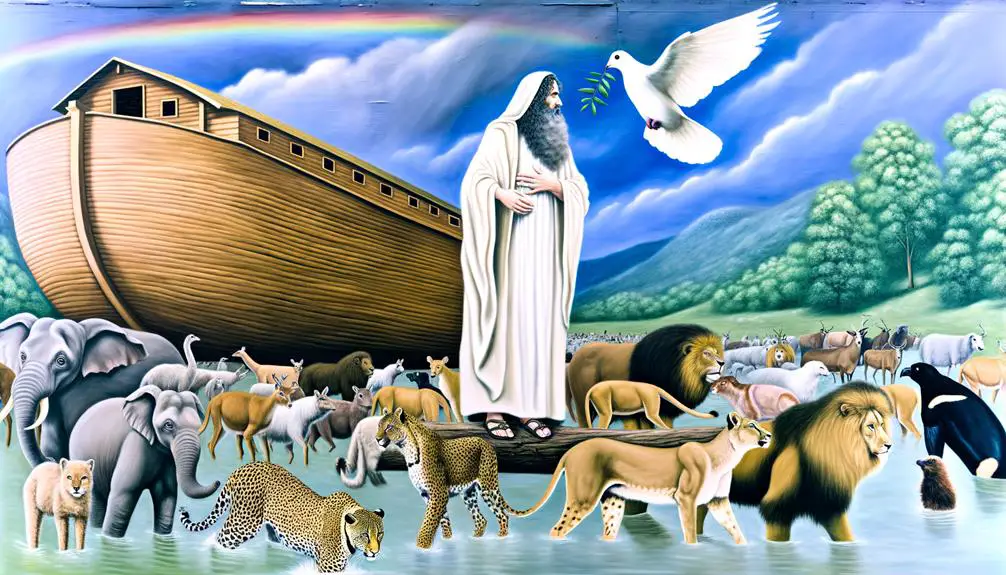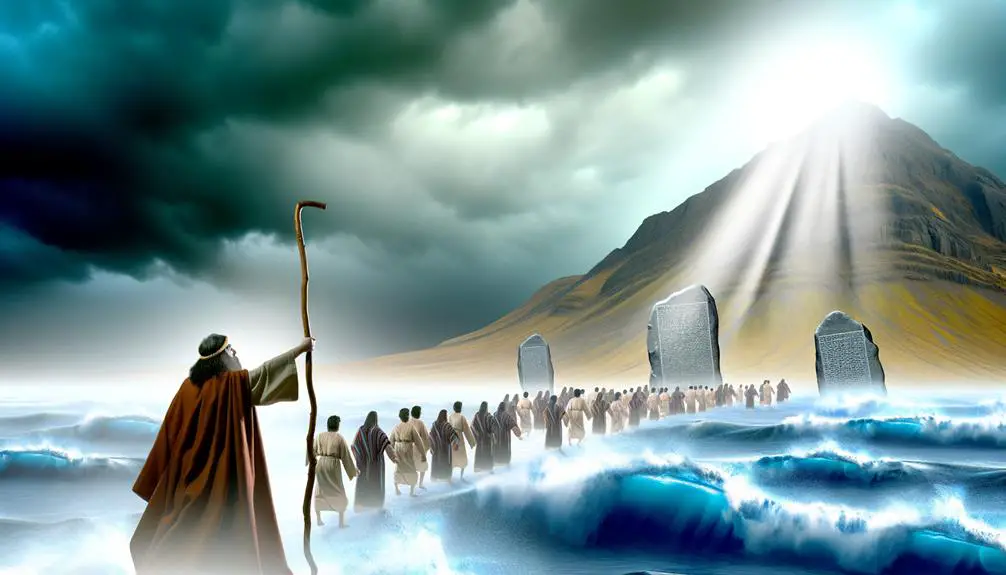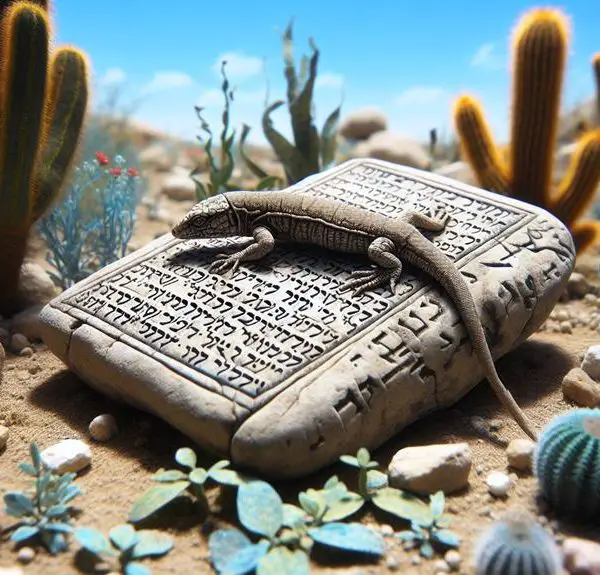Navigate through the lives of Noah, Nehemiah, and more, uncovering timeless lessons in leadership and faith that still echo today.

List of Men in the Bible
You might think discussing men of the Bible is just a recount of ancient history, but it's far more captivating than that.
From Adam's initial steps in Eden to Paul's transformative journeys across the Gentile world, these figures' lives are interwoven with themes of faith, redemption, and leadership that resonate deeply today.
As we explore characters like Noah, Abraham, Moses, and David, you'll discover that their stories are not merely tales from the past but are filled with insights and principles that can guide us in the present.
So, let's embark on this journey together, and you might find unexpected inspiration in their narratives.
Key Takeaways
- Men in the Bible, like Adam, Moses, and David, play pivotal roles in humanity's spiritual and moral development.
- Biblical figures such as Abraham and Paul highlight the importance of faith, covenant relationships, and missionary work in religious history.
- Stories of these men often include themes of redemption, divine guidance, and leadership, reflecting broader theological and societal implications.
- Their legacies, from establishing covenants to spreading Christianity, have profoundly impacted both historical events and religious beliefs.
Adam: Humanity's Beginning

Adam, often considered the progenitor of humankind, marks the inception of human history according to biblical narratives. His existence and actions within the Garden of Eden set a precedent for human behavior, morality, and the complex relationship between humans and the divine. In this analysis, you'll delve into the significance of Adam's creation, his role within the Garden, and the pivotal moment of Eve's creation, which collectively underscore the foundational aspects of human nature and societal norms.
The narrative of Adam's life in the Garden of Eden, a paradisiacal setting, provides critical insights into the envisioned ideal state of humanity and its subsequent fall. This environment, characterized by harmony between Adam and nature, serves as a backdrop for exploring themes of innocence, stewardship, and the beginning of human curiosity and disobedience. The act of Eve's creation from Adam's rib, as depicted in these narratives, symbolizes the interconnectedness and inherent equality between genders, despite subsequent interpretations that have varied widely.
Furthermore, the interaction between Adam, Eve, and the forbidden fruit introduces the concept of free will and the repercussions of one's actions. This pivotal event not only marks the end of innocence for Adam and Eve but also illustrates the inherent flaw and beauty of human choice, setting the stage for the complex moral landscapes navigated by their descendants.
In examining Adam's story, you're not just exploring ancient text but are uncovering the layers of meaning that have influenced countless generations. This analysis reveals the depth of human character, the struggle between obedience and desire, and the perpetual quest for knowledge and redemption.
Noah: Survivor of the Flood

You'll find Noah's narrative deeply interwoven with themes of obedience, survival, and environmental upheaval.
His construction of the Ark, under divine instruction, not only showcases his faith but also sets a precedent for human resourcefulness in the face of impending disaster.
The global flood's impact and the rescue of animal pairs further highlight the interconnectedness of humanity and nature, urging a reevaluation of our stewardship of the earth.
Noah's Ark Construction
Commissioned by God, Noah undertook the monumental task of constructing an ark, a feat that not only demonstrated his unwavering faith but also his adherence to divine instructions amidst impending cataclysm. This endeavor grants insight into ancient shipbuilding techniques, revealing a sophisticated understanding of carpentry and design far ahead of its time.
Through an environmental impact analysis, one might ponder the resources required for such a construction—wood, pitch, and labor—and how their extraction and utilization reflected upon the environment of the time. Noah's compliance with the specified dimensions and materials underscores a meticulous application of these techniques, emphasizing a harmonious balance between divine command, human ingenuity, and environmental stewardship.
This narrative serves as a testament to the resilience and resourcefulness of ancient peoples faced with divine mandates and existential threats.
Global Flood Impact
Having explored Noah's construction of the ark, we now turn our attention to the profound effects of the global flood he survived, examining its implications on both human societies and the natural world.
The impact of the flood can be analyzed through:
- Cultural mythology comparisons: The story of Noah finds echoes in flood myths worldwide, from Mesopotamia's Epic of Gilgamesh to the Hindu Puranas, suggesting a shared cultural memory of a cataclysmic event.
- Geological evidence debates: Scientists and scholars engage in ongoing debates over the existence of geological evidence supporting a global flood, examining sediment layers and fossil records for clues.
- Societal resets: The narrative of the flood as a reset for humanity invites examination of its effects on early societies, possibly influencing governance, morality, and survival strategies in the aftermath.
Animal Pair Rescue
Noah's endeavor to rescue pairs of animals, as instructed in biblical accounts, marks a pivotal moment in the narrative, highlighting the preservation of biodiversity amidst catastrophic events. This ancient story parallels modern conservation efforts where biodiversity is under threat from climate change, habitat destruction, and other anthropogenic factors.
Just as Noah's ark served as a sanctuary for animal pairs, today's emergency animal shelters strive to protect wildlife and domestic animals from natural disasters and human-made crises. These contemporary efforts underscore the ongoing relevance of Noah's mission, illustrating a timeless commitment to safeguarding the planet's biological heritage.
Emergency shelters, much like the biblical ark, symbolize hope and resilience, emphasizing the critical importance of proactive measures in the face of environmental challenges.
Abraham: Father of Nations

Abraham, often revered as the patriarch of the Israelite nation, plays a crucial role in the narratives of Judaism, Christianity, and Islam. His story, deeply embedded in religious texts, underscores themes of faith, obedience, and the complexities of divine-human relationships. A central aspect of Abraham's narrative involves Sarah's barrenness and a covenant promise that unfolds in a dramatic fashion, impacting generations.
- Sarah's Barrenness: Sarah's inability to bear children initially poses a significant challenge to the fulfillment of the covenant promise. This situation tests Abraham's faith and patience, as he navigates the tension between divine promise and human reality.
- Covenant Promise: The covenant between Abraham and God is a foundational event, where God promises Abraham that he'll be the father of a multitude of nations. This promise, despite Sarah's initial barrenness, signifies a divine intervention into human history and establishes a perpetual bond between Abraham's descendants and God.
- Legacy and Impact: Abraham's legacy transcends his immediate family. He's considered a seminal figure in the Abrahamic religions, with his faith and actions serving as a model for millions. The narrative of his life and the fulfillment of the covenant promise through the birth of Isaac symbolize hope, faith, and the belief in the possibility of the miraculous.
Analyzing Abraham's story, one observes a complex interplay between divine will and human action. His life illustrates how faith, obedience, and perseverance can transcend seemingly insurmountable obstacles, setting a precedent for future generations to follow.
Moses: Liberator and Lawgiver

Following Abraham's narrative, the story of Moses emerges as a critical juncture in the evolution of the Israelite identity, embodying the roles of liberator and lawgiver. Unlike Abraham, Moses' path is marked by direct divine intervention and a series of miraculous events, culminating in the Exodus from Egypt. However, his journey isn't without personal challenges. Moses' speech impediment, for instance, is a notable aspect of his character, underscoring his initial reluctance to assume the mantle of leadership. Despite this, he becomes a conduit for divine will, showcasing that physical limitations don't preclude one from fulfilling their destiny.
Moses' encounter with God at Mount Sinai represents a pivotal moment not only in his life but in the spiritual heritage of the Israelites. It's here that he receives the Ten Commandments, a moral and legal framework that would govern Israelite society and influence Western legal systems for millennia. This event epitomizes Moses' role as lawgiver, establishing a covenant between God and the Israelites that redefines their relationship and sets them apart as a chosen people.
Analyzing Moses' leadership, it's evident that his impact extends beyond liberation from physical bondage. He lays the foundation for a communal identity rooted in a shared covenant with the divine. Despite his initial hesitancy and personal limitations, Moses' legacy as a lawgiver and leader underscores the transformative power of faith and obedience to a higher calling. His story is a testament to the enduring significance of moral and spiritual leadership in shaping collective identity.
David: Shepherd King

You'll find that David's journey from a humble shepherd to the revered King of Israel encapsulates themes of faith, bravery, and leadership.
His early life sets the stage for his unexpected victory against Goliath, highlighting the importance of divine favor and inner strength.
As king, his reign is marked by both wisdom and complexity, shaping the narrative of biblical leadership and governance.
Early Life of David
Before ascending to the throne of Israel, David's early life as a shepherd profoundly shaped his character and leadership abilities. His experiences in the fields, safeguarding his flock, nurtured qualities such as courage, compassion, and an unwavering faith in God. These qualities not only prepared him for future challenges but also enriched his musicianship, a talent that would later find favor in the court of King Saul.
However, David's rise wasn't without its trials:
- David's Musicianship: His skill with the lyre brought him into Saul's service, providing solace to the troubled king.
- Saul's Jealousy: As David's popularity grew, so did Saul's envy, marking the beginning of a complex relationship.
- Leadership Skills: His early responsibilities as a shepherd laid the foundation for his future as a leader, emphasizing the importance of humility and diligence.
Goliath Battle Victory
While David's early life and musicianship laid the foundation for his unique leadership qualities, it was his victory over Goliath that truly marked his emergence as a shepherd king. Goliath's height, towering over his contemporaries, symbolized the insurmountable challenge he represented.
Yet, David's strategy, relying not on conventional warfare but on his slingshot skills honed during his shepherd days, underscored his innovative approach to leadership and problem-solving. This victory didn't just signify a physical triumph over a giant; it epitomized the triumph of wisdom and faith over brute strength.
David's ability to leverage his unique skills, coupled with his unwavering faith, set a precedent for his future leadership style, emphasizing adaptability, strategic thinking, and a deep reliance on divine guidance.
Reign as King
Upon ascending to the throne, David transitioned from a shepherd to a king, illustrating a profound evolution in leadership and governance. His reign marked a crucial period in the establishment of a royal lineage and the execution of kingly duties. David's story offers a unique perspective on:
- Leadership Dynamics: Emphasizing the shift from pastoral care to ruling a nation.
- Royal Lineage: Cementing his descendants' place in history, David's lineage carried significant theological and historical implications.
- Kingly Duties: Beyond military conquests, his reign involved judicial, religious, and administrative responsibilities.
David's tenure as king underscores the complexities of biblical leadership, weaving together personal virtue, divine favor, and the burdens of governance. Analyzing his reign offers insights into the multifaceted role of kingship within the biblical narrative.
Paul: Apostle to the Gentiles

Paul's transformation from a persecutor of Christians to the Apostle to the Gentiles marks a pivotal moment in Christian history. This remarkable transition, often referred to as Paul's conversion, isn't just a testament to personal change but also underscores the expansive reach of Christianity beyond the Jewish community. Before his conversion, Paul, then known as Saul, was an ardent opponent of the Christian faith, actively participating in the persecution of Christians. However, the event on the road to Damascus, where he experienced a vision of Jesus, radically altered his life's trajectory.
Following his conversion, Paul embarked on several missionary journeys across the Roman Empire. These travels weren't merely exploratory but were aimed at spreading the Christian message to Gentile communities, thereby fulfilling his role as the Apostle to the Gentiles. His missionary endeavors led to the establishment of several Christian communities in key cities, significantly contributing to the growth and spread of Christianity.
Paul's epistles, many of which form a substantial part of the New Testament, further highlight his pivotal role. Through his letters, Paul addressed theological issues, provided guidance to newly established churches, and articulated the core tenets of Christian faith in a manner that was both accessible and relatable to a Gentile audience. His writings not only served immediate pastoral needs but have continued to influence Christian thought and doctrine throughout history.
In analyzing Paul's contribution, it's evident that his missionary journeys and theological insights played a crucial role in shaping Christianity's early development and its universal message. His legacy, as the Apostle to the Gentiles, underscores the inclusive nature of Christian salvation, extending beyond the confines of Jewish tradition to embrace all humanity.
Frequently Asked Questions
How Do Biblical Scholars Reconcile the Differences in Character Portrayals Between the Old and New Testaments, Especially Concerning Figures Like Paul Who Have a Significant Role in Both?
You're delving into how scholars analyze the portrayal differences, particularly with Paul, across the Testaments.
They often view these variations through the lens of theological consistency, emphasizing Paul's conversion as a pivotal moment.
This approach allows them to reconcile character changes by understanding his transformation as part of a broader, divine narrative.
It's a method that respects the complexity of these texts while seeking to understand the underlying unity in their messages.
What Archaeological Evidence Exists to Support the Historical Existence of These Biblical Figures, Particularly Those Like David, Whose Reign Has Been a Topic of Extensive Research and Debate?
You're in for a wild ride when diving into the evidence of biblical figures' existence. Specifically, the Tel Dan Stele and Jerusalem Archaeology offer compelling insights. These findings shine a light on David's historical presence, stirring up the academic pot.
Through the lens of these discoveries, scholars meticulously analyze and debate the authenticity and implications, providing a more nuanced understanding of these ancient narratives. It's a testament to the relentless pursuit of historical truth.
How Have Modern Interpretations and Critiques of the Bible Changed Our Understanding of These Men's Roles and Actions, Especially in the Context of Contemporary Ethical and Moral Standards?
You're witnessing a shift in how biblical figures are perceived today. Modern interpretations and critiques challenge traditional views on gender roles and leadership styles. They prompt you to re-evaluate these men's actions and roles through the lens of contemporary ethical and moral standards.
This analytical approach encourages a deeper understanding of their complexities and the societal norms of their times, offering a more nuanced perspective on their contributions and flaws.
In What Ways Have the Stories of These Biblical Figures Been Adapted or Referenced in Popular Culture, and How Do These Adaptations Influence Our Perception of Their Original Biblical Narratives?
You've seen cinematic portrayals and literary adaptations breathe new life into age-old stories. These modern renditions often reshape your understanding of the original narratives.
Considering the Diverse Cultural and Religious Backgrounds of the Bible's Authors, How Do Scholars Approach the Task of Understanding and Explaining the Historical Context and Motivations Behind the Portrayal of These Figures, Such as Moses and Abraham, in Their Respective Stories?
When tackling the historical context and motivations behind figures like Moses and Abraham, scholars use textual analysis and delve into cultural symbolism.
They cross-reference ancient texts and archaeological findings to piece together the cultural and religious backgrounds of the authors.
This approach helps you understand the layers of meaning and the societal values that influenced these stories, offering a richer, more nuanced view of these historical figures and their narratives.
Conclusion
In analyzing these biblical figures, it's evident that each embodies endurance, enlightenment, and evolution within the human spirit. From Adam's awakening to Paul's passionate proselytizing, their stories stitch together a sacred tapestry, showcasing strength in spirituality and sovereignty in servitude.
These narratives not only mirror mankind's moral milestones but also magnify the monumental moments of faith, failure, and forgiveness. Thus, through theological lenses, their lives lend invaluable insights into the intricate interplay of divinity and humanity.



Sign up